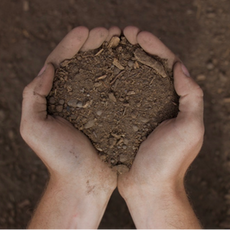PRICES DO NOT INCLUDE DELIVERY, GST OR BULK BAG COST
As Recommended by the Composting Council of Canada
Flower beds
-
Aerate your lawn before topdressing. Then spread 1/3 to 1 1/4 cm (1/8” to 1/2”) of compost evenly over the area using a rake. Water the area thoroughly. Water helps the compost move through the thatch layer, to the soil surface and into aeration holes.
Top Dressing of Established Lawns
-
For lawns that are going to be seeded or sodded, apply about 2 1/2 to 5 cm (1” - 2”) of compost and rototill to a depth of 12 cm (5”). For seeded lawns, apply seed and then spread a thin layer of compost to cover seed. Compost helps increase grass seed germination by providing adequate seed to soil contact, moisture and balanced nutrients.
New Lawn Establishment
-
Work 2 1/2 cm (1”) of compost or soil enhancer into the soil. Water until the entire root zone is saturated. For new beds, add 2 1/2 to 5 cm (1” - 2”) of compost and rototill to at least a 12 cm (5”) depth. Most annuals and perennials do quite well in compost-amended soils.
Planting Trees
-
Rototill up to 5 times the diameter of the rootball of the tree to be planted. Add about 30% compost by volume to the area and mix thoroughly outside the hole with the native soil. Place the tree into the hole and use the compost amended soil mixture as a backfill around the rootball. It is important to make sure that there are no air pockets around the roots as you backfill the hole. Remove excess soil and water thoroughly.
Vegetable Gardens
-
Apply about 2 1/2 cm (1”) of compost and rototill into the soil to a depth of 12 cm (5”). You may need to apply compost on a yearly basis to poor soils until the proper nutrient level has been established. Do not over-apply compost because many vegetables will not produce high yields if there is excess nitrogen in the soil.
Flowers and Plants
-
For optimum mulch application results around annuals, perennials and other landscape plants, use a 5 cm (2”) layer of compost. Avoid over- or under-mulching because other problems can arise, such as smothering of root systems. Grade the mulch so water flows away from trunks reducing chances for crown rot. Finer compost does not suppress weeds as well as coarse-textured composts do.
Do You Know What's in Your Garden Soil?
Alberta soil is a heavy clay type of soil, a Clay Based Soil also has its benefits.
Clay soil has some good qualities. Clay, because of its density, retains moisture well. It also tends to be more nutrient-rich than other soil types. The reason for this is that the particles that make up clay soil are negatively charged, which means they attract and hold positively charged particles, such as calcium, potassium, and magnesium.
To improve your soil, you'll need to add 2 to 4 inches of organic matter to the entire bed. You can add any organic matter you can get your hands on. Aged Montaine mulch, Peat Moss and Compost are perfect choices. Spread your organic matter on top of the soil. then mix into the top 6 to 8 inches of soil. Please note that peat moss especially has hydrophobic tendencies until it has been well moistened so be sure to give it a good drink!
Unfortunately, when sand is added directly to clay type Soil, the result is something that more accurately resembles concrete. Clay soils are best improved with the addition of compost and other organic materials only.
Tips and information to help your plants grow:
-
Plants get their food from the soil around them.
-
Organic matter is the key to fixing heavy soils.
-
Screened Loam contains sand silt and clay in almost equal proportions. Due to its composition, screened loam holds moisture well. Check out our Triple Mix Garden Mix and Quad Mix Garden Soil for quality garden soils you can plant directly into.
-
The essential basic nutrients for your plants are Carbon, Nitrogen, Phosphorus, and Potassium. These important nutrients can be supplied through the addition of a soil amendment such as Compost Peat Moss, and Montane Mulch.









